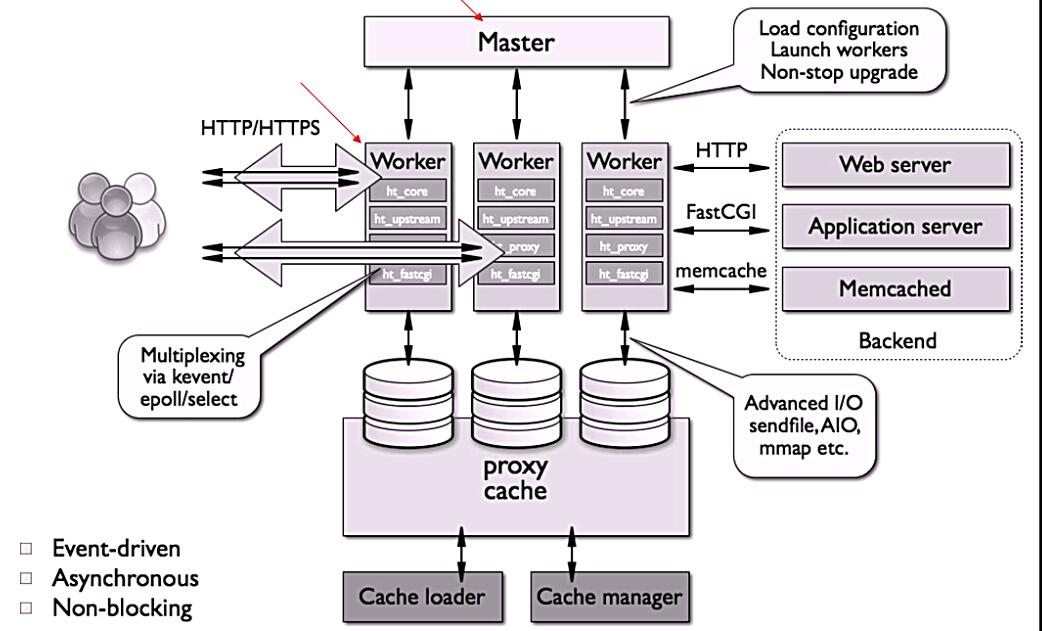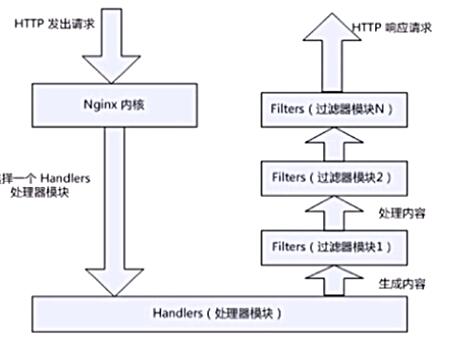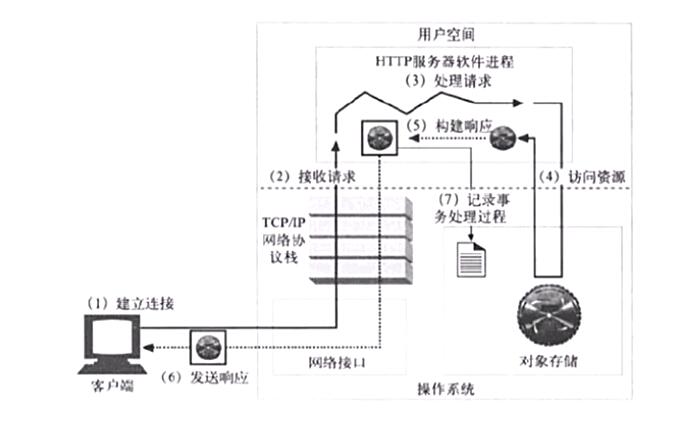Working principle and configuration of nginx
Module and working principle of nginx
Nginx consists of kernel and modules. Among them, the design of the kernel is very small and concise, and the work completed is also very simple. Only by looking up the configuration file, the client request is mapped to a location block (location is an instruction in nginx configuration for URL matching), and each instruction configured in this location will start different modules to complete the corresponding work.
Module classification of nginx
The module of nginx is divided into core module, basic module and third-party module
- HTTP module, EVENT module and MAIL module are core modules
- HTTP Access module, HTTP FastCGI module, HTTP Proxy module and HTTP Rewrite module are basic modules
- HTTP Upstream module, Request Hash module, Notice module and HTTP Access Key module belong to third-party modules
Modules developed by users according to their own needs belong to third-party modules. It is with the support of so many modules that the function of nginx will be so powerful
nginx modules are divided into three types in terms of function:
- Handlers. This kind of module directly processes the request, outputs the content and modifies the header information. Generally, there can only be one handler module
- Filters. This kind of module is mainly used to modify the output of other processor modules, and finally output by nginx
- Proxies (agent module). It is the HTTP Upstream module of nginx. These modules mainly interact with some back-end services, such as fastcgi, to realize the functions of service proxy and load balancing
nginx module is divided into: core module, event module, standard Http module, optional Http module, mail module, third-party module and patch
- Nginx basic modules: the so-called basic modules refer to the default function modules of nginx. The instructions provided by them allow you to use variables that define the basic functions of nginx. They cannot be disabled during compilation, including:
- Core module: basic functions and instructions, such as process management and security. Most of the common core module instructions are placed at the top of the configuration file
- Event module: the ability to configure network usage in Nginx. Most of the common events module instructions are placed at the top of the configuration file
- Configuration module: provides an inclusion mechanism
How nginx works
Nginx modules are directly compiled into nginx, so they belong to static compilation.
After starting nginx, the module of nginx is loaded automatically. Unlike Apache, first compile the module into a so file, and then specify whether to load it in the configuration file.
When parsing the configuration file, each module of nginx may process a request, but the same processing request can only be completed by one module.
Process architecture of nginx:
When nginx is started, a Master process will be started. This process does not process any client requests. It is mainly used to generate worker threads. A worker thread is used to process n requests.

The following figure shows a routine HTTP request and response process of nginx module

The following figure shows the basic WEB service request steps

Installation and configuration of nginx
nginx installation
Create system user nginx
[root@localhost ~]# useradd -r -M -s /sbin/nologin nginx
Installation dependent environment
[root@localhost ~]# yum -y install pcre-devel openssl openssl-devel gd-devel gcc gcc-c++
[root@localhost ~]# yum -y groups mark install 'Development Tools'
Last metadata expiration check: 2:59:11 Before, it was executed at 01:04:32 on Monday, October 25, 2021.
Dependency resolution.
=============================================================
software package framework edition Warehouse size
=============================================================
Installation group:
Development Tools
Transaction summary
=============================================================
complete!
Create log storage directory
[root@localhost ~]# mkdir -p /var/log/nginx [root@localhost ~]# chown -R nginx.nginx /var/log/nginx
Download nginx
[root@localhost ~]# cd /usr/src/ [root@localhost src]# wget http://nginx.org/download/nginx-1.12.0.tar.gz --2021-10-25 04:06:16-- http://nginx.org/download/nginx-1.12.0.tar.gz Resolving host nginx.org (nginx.org)...
Compile and install
[root@localhost src]# ls debug kernels nginx-1.12.0.tar.gz [root@localhost src]# tar xf nginx-1.12.0.tar.gz [root@localhost src]# cd nginx-1.12.0 [root@localhost nginx-1.12.0]# ./configure \ --prefix=/usr/local/nginx \ --user=nginx \ --group=nginx \ --with-debug \ --with-http_ssl_module \ --with-http_realip_module \ --with-http_image_filter_module \ --with-http_gunzip_module \ --with-http_gzip_static_module \ --with-http_stub_status_module \ --http-log-path=/var/log/nginx/access.log \ --error-log-path=/var/log/nginx/error.log [root@localhost nginx-1.12.0]# make -j $(grep 'processor' /proc/cpuinfo | wc -l) && make install
nginx configuration
Service control mode, using nginx command
Configure environment variables
[root@localhost ~]# echo 'export PATH=/usr/local/nginx/sbin:$PATH' > /etc/profile.d/nginx.sh [root@localhost ~]# . /etc/profile.d/nginx.sh
Service control mode, using nginx command
-t check the configuration file syntax
[root@localhost ~]# nginx -t nginx: the configuration file /usr/local/nginx/conf/nginx.conf syntax is ok nginx: configuration file /usr/local/nginx/conf/nginx.conf test is successful
-v output the version of nginx
[root@localhost ~]# nginx -v nginx version: nginx/1.20.1
-c specify the path of the configuration file
[root@localhost ~]# nginx -s stop ; nginx -c /opt/nginx.conf ##Directly stop and start [root@localhost ~]# ps -ef|grep nginx root 99290 1 0 03:32 ? 00:00:00 nginx: master process nginx -c /opt/nginx.conf nginx 99291 99290 0 03:32 ? 00:00:00 nginx: worker process nginx 99292 99290 0 03:32 ? 00:00:00 nginx: worker process root 101138 1653 0 03:33 pts/0 00:00:00 grep --color=auto nginx
-s sends a service control signal. The optional values are {stop | quit | reopen}
[root@localhost ~]# nginx -s quit [root@localhost ~]# ss -antl State Recv-Q Send-Q Local Address:Port Peer Address:Port Process LISTEN 0 128 0.0.0.0:22 0.0.0.0:* LISTEN 0 128 [::]:22 [::]:*
Detailed explanation of nginx configuration file
Main configuration file: / usr/local/nginx/conf
- When nginx is started by default, the configuration file used is the installation path / conf/nginx.conf file
- You can specify the configuration file to read with the - c option when you start nginx
Common configuration files of nginx and their functions
| configuration file | effect |
|---|---|
| nginx.conf | Basic configuration file of nginx |
| mime.types | Extension files associated with MIME types |
| fastcgi.conf | fastcgi related configurations |
| proxy.conf | proxy related configuration |
| sites.conf | Configure the websites provided by nginx, including virtual hosts |
Detailed explanation of nginx.conf configuration
The content of nginx.conf is divided into the following paragraphs:
- Mainconfiguration segment: global configuration segment. The main configuration section may contain the event configuration section
- Event {}: define the working characteristics of the event model
- http {}: defines the configuration related to the http protocol
Sample Nginx configuration file
[root@localhost ~]# vim /usr/local/nginx/conf
# Global block
user www-data; ##user
worker_processes 2; ## The default is 1. It is generally recommended to set the number of CPU cores to 1-2 times
error_log logs/error.log; ## Error log path
pid logs/nginx.pid; ## Process id
# Events block
events {
# Use epoll's I/O model to handle polling events.
# It can not be set. nginx will select the appropriate model according to the operating system
use epoll;
# The maximum number of connections for the worker process. 1024 by default
worker_connections 2048;
# Keep alive timeout at http level
keepalive_timeout 60;
# Buffer size of the client request header
client_header_buffer_size 2k;
}
# http block
http {
include mime.types; # Import file extension and file type mapping table
default_type application/octet-stream; # Default file type
# Log format and access log path
log_format main '$remote_addr - $remote_user [$time_local] $status '
'"$request" $body_bytes_sent "$http_referer" '
'"$http_user_agent" "$http_x_forwarded_for"';
access_log logs/access.log main;
# sendfile mode is allowed to transfer files. The default value is off.
sendfile on;
tcp_nopush on; # Only when sendfile is on.
# http server block
# Simple reverse proxy
server {
listen 80;
server_name domain2.com www.domain2.com;
access_log logs/domain2.access.log main;
# Forward dynamic request to web application server
location / {
proxy_pass http://127.0.0.1:8000;
deny 192.24.40.8; # Rejected ip
allow 192.24.40.6; # Allowed ip
}
# Error page
error_page 500 502 503 504 /50x.html;
location = /50x.html {
root html;
}
}
# load balancing
upstream backend_server {
server 192.168.0.1:8000 weight=5; # The higher the weight, the greater the weight
server 192.168.0.2:8000 weight=1;
server 192.168.0.3:8000;
server 192.168.0.4:8001 backup; # Hot standby
}
server {
listen 80;
server_name big.server.com;
access_log logs/big.server.access.log main;
charset utf-8;
client_max_body_size 10M; # Limit the file size uploaded by the user. The default is 1M
location / {
# Using proxy_pass forwards the request to a set of application servers defined through upstream
proxy_pass http://backend_server;
proxy_set_header X-Forwarded-For $proxy_add_x_forwarded_for;
proxy_set_header Host $http_host;
proxy_redirect off;
proxy_set_header X-Real-IP $remote_addr;
}
}
}
Configuration instruction: to end with a semicolon, the syntax format is as follows:
derective value1 [value2 ...];
Supported variables:
- Built in variable: the module will provide built-in variable definitions
- Custom variable: set var_name value
Configuration parameters for debugging and locating problems
daemon {on|off}; //Whether to run nginx as a daemon. It should be set to off during debugging
master_process {on|off}; //Whether to run nginx in the master/worker model. It can be set to off during debugging
error_log Location level; //Configure error log
